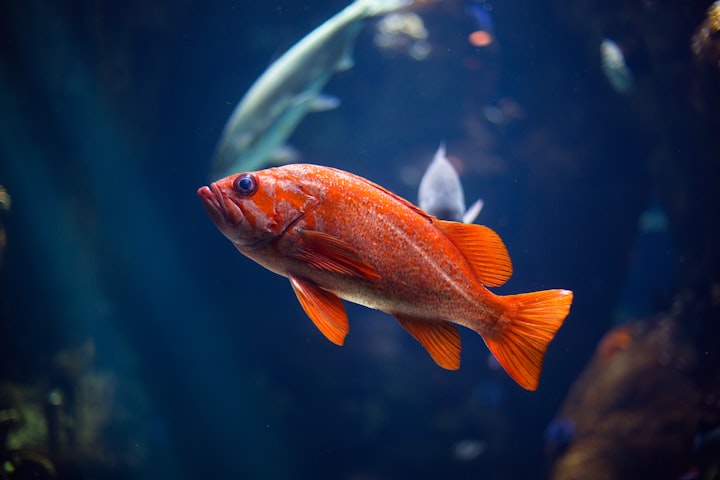The deep-seated reasons for the success or failure of home breeding ornamental fish
The original is a fish tank filtration system

This article discusses important knowledge about fish keeping with those who like to keep fish
Filtration System
Why go to all the trouble of discussing the issue of filtration systems? Because: filtration systems are so important to fish farming! It is no exaggeration to say: fish farming is equal to water, and water is about equal to filtration. Conversely, poor filtration is equal to dead fish.
There must be someone who opposes this statement. Because the ancients also raised fish, but the ancients did not have filtration equipment, there is no talk of establishing a filtration system. We, modern people, keep fish, many fish lovers are fans of the ancient method of fish farming, and also do not need to filter, fish as usual.
So, is it okay to keep ornamental fish without filtration equipment? The answer is: yes. However, the ancient method of fish farming also follows the scientific principle of water purification. The ancients may not know the principle of the filtration system, but they accumulated the right practices little by little in a lot of practice, after sacrificing countless "fish lives", and passed down these correct methods. In other words, although the ancients did not use filtration equipment, they unconsciously followed the scientific principle of water purification, which is the same as the use of filtration systems, both to maintain good and stable water quality in the fish tank. Even so, the ancient method of keeping fish without filtration equipment is still more difficult to take care of than a tank equipped with filtration equipment, and the fish are more likely to have problems.
In this article, I will analyze the principle of the filtration system from four aspects and the way to build a fish tank filtration system.
First, why do you need a filtration system?
Second, what is the principle of a filtration system?
How to set up a filtration system?
How to take care of the filtration system?
If you intend to carry out the ancient method of fish farming to the end, then you should know more about this knowledge. Because there are thousands of ways to raise fish, there is no right or wrong, but the principle of science is unchanging and inviolable, only in the essence of understanding the principle of water purification, it is possible to keep ornamental fish alive and well, to live up to the life of the fish, and then raise the state of clear water and beautiful fish.
A. Why do you need to be equipped with a filtration system?
To answer this question, we have to start with the "ecological" cycle of the fish tank.
You have a tank of ornamental fish, fish live in the water, eat in the water, breathe in the water, but also the water excretion, fish food residues also remain in the water, fish body secretion of mucus is also present in the tank water. Common sense tells us that if this continues, it won't take long for the water to stink.
Fish feces, bait, fish secretions ...... we will collectively refer to these as water pollutants. They exist in the water as particles of different sizes and shapes, making the water of the fish tank cloudy. The turbid water, in addition to affecting the ornamental effect, the health of the fish is not very harmful. Most of the water in nature is cloudy, but the fish living in it is not a problem at all. What is fatal is that these pollutants will be decomposed by the bacteria in the water, and in the process of decomposition will be converted into ammonia nitrogen, and nitrite. These substances are toxic and dissolve in water, invisible to the naked eye, and when their concentration in the water reaches a certain level, ornamental fish will die of poisoning. Novice fishermen often wonder: the water in the tank looks very clear, why do the fish still die one by one? The reason is ammonia and nitrite poisoning.
To keep your fish healthy in the water and stay with you for a long time, you must try to reduce the concentration of these harmful substances in the water. However, there is no particularly simple and low-cost way to separate ammonia and nitrite from the water. The straightforward and crude approach is to change the water, by changing the water, dilute the concentration of these substances in the water. The second way is to reduce the source of ammonia nitrogen and nitrite production, either by reducing the number of fish, reducing the amount of fish food fed, or by timely fishing out fish waste and residual bait, and by reducing organic matter, reducing the source of harmful substances produced in the water. These methods are the essence of ancient fish farming - more water, dilution, less feeding, diligent fish manure fishing, and diligent tank cleaning. If you can do the above points, the ancient method of fish farming can be tried.
If you can not do so diligently, then you should equip the fish tank with filtration equipment. Through the role of the filtration system, remove the ammonia and nitrite, and other harmful substances in the water, to achieve the purpose of "water purification" and maintain a suitable water quality environment for the survival of ornamental fish.

Second, what is the principle of filtration system operation?
How does the filtration system remove the toxic substances in the water? Answer: By using vitrifying bacteria.
We do not have an effective way to directly separate ammonia and nitrite from the water, fish lovers are abhorrent to ammonia and nitrite, they pose a threat to fish life, but some bacteria, precisely like ammonia and nitrite, to them as "food", rely on the transformation of ammonia and nitrite in the energy, survival, and reproduction.
First, some bacteria that use ammonia as "food" convert ammonia into nitrite, and then another type of bacteria that uses nitrite as "food" comes on the scene. This bacteria can break down nitrite into nitrate. Nitrate is a low-toxic substance, that will not kill the fish, we just rely on a small number of water changes to dilute the concentration of nitrate, and you can create a suitable living environment for fish.
We will convert ammonia and nitrite bacteria, collectively called vitrifying bacteria. Therefore, vitrifying bacteria is not a kind of bacteria, but a collective name for a variety of bacteria.
At this point, fishermen must be wondering: where are the vitrifying bacteria? How can we have them?
Vitrifying bacteria are commonly found in water and air, and there are a large number of vitrifying bacteria in natural water, riverbed, and sediment ....... It's just that we keep ornamental fish at home, compared to nature, it's a small body of water and high-density feeding. The amount of vitrifying bacteria present in the air and water is far from enough to deal with the toxic substances produced in the water. Only through special methods, a sufficient number of vitrifying bacteria can be cultivated to be able to deal with the toxic substances in the water.
Fish farmers often say that nourishing water has little to do with water, but mainly cultivate with mg vitrifying bacteria. The use of vitrifying bacteria to remove toxic ammonia nitrogen and nitrite from the water, we call it the nitrification system. As long as the nitrification system is established, fish farming basically will not have any major problems.
Here is a concept that needs to be clarified for fish lovers, which is the nitrification system and filtration system. I have already explained the nitrification system. The filtration system contains the nitrification system, but is not the same as the nitrification system, it has another important component: the physical filtration system. The physical filtration system, in layman's terms, is a system that filters the visible organic matter in the water through physical filtering media. The physical filtration system and the nitrification system are combined to form a filtration system.
Third, how should the filtration system be set up?
The filtration system is very important for fish farming, so how should we build a complete filtration system?
To clarify this issue, we must continue to talk about vitrifying bacteria.
Vitrifying bacteria have three characteristics: parasitic, aerobic, and anaerobic.
Parasitism means that vitrifying bacteria need to be attached to a solid substance and cannot float in the water column. Like people, vitrifying bacteria need a house to live in. Only when they are settled in a house can vitrifying bacteria proliferate. The amount of vitrifying bacteria in the water and air is very small compared to the number of vitrifying bacteria that live in a "house". Therefore, we need biochemical filter media. Biochemical filter media is a "house" for vitrifying bacteria to live in. To provide as much space as possible for vitrifying bacteria to live, we make the biochemical filter media into something with more pores, the more pores, the larger the surface area, and the more vitrifying bacteria can be hosted. Whether it is biochemical cotton, or ceramic ring, bacteria house, their commonality is more pores, the essence of the function is to parasitism vitrifying bacteria.
The so-called oxygen-loving is that the process of converting ammonia nitrogen and nitrite by vitrifying bacteria needs enough oxygen to participate, as long as the lack of oxygen, vitrifying bacteria can not complete the conversion work, they can not get energy themselves, can not proliferate, not to mention the role of removing toxic substances in the water body. Therefore, we need pumps to pump water and keep the water body in circulation, with the purpose of letting the flowing water bring sufficient oxygen to participate in the work of vitrifying bacteria.
By light aversion, we mean that vitrifying bacteria cannot survive in direct sunlight, so the biochemical filter media needs to be shaded, either in an opaque box or in the bottom of a cabinet or filter bucket where the light is low.
In addition, vitrifying bacteria are more susceptible to other bacteria. Where other bacteria are present, it is difficult for the vitrifying bacteria to survive. Therefore, we need to add physical filtration to the filtration to block large particles of organic matter from landing on the biochemical filter media. Once the large organic matter falls on the biochemical filter media, other bacteria will gather around the organic matter and break it down, thus encroaching on the living space of the vitrifying bacteria.
The filtration system consists of two main components, namely physical filtration and biochemical filtration. These two types of filtration complement each other and work together to achieve the effect of water purification.
Physical filtration is like a fine sieve, when the water passes through this "sieve", it is not decomposed organic matter is intercepted, and then through the cleaning of the "sieve" to achieve the purpose of removing the larger organic matter in the water. Another role of physical filtration is to block organic matter from entering the biochemical filter material, which is afraid of organic matter, as mentioned in the previous article.
Undertake the physical filtration function of the filter media, mainly relatively fine filter cotton, the market is a common magic carpet, magic bag, white cotton, blue cotton, etc. Physical filtration of the filter material must be placed on the top layer of all the filter material, that is, the water pumped out from the pump, must first flow through the physical filter material, in addition to the purpose of blocking organic matter, but also plays another important role, is to break up the water flow. Because no matter what the waterway, the water flow is not evenly distributed to the filter media, water if straight up and down, then the area in contact with the biochemical filter media is very little, no contact with the water filter media will not get oxygen transport, equivalent to the idle filter media, which is a total waste. The filter cotton placed in the first layer of the filter media plays a key role in breaking up the water flow, so that the water flows more evenly to the filter media below the filter cotton, and is in full contact with the biochemical filter media, to effectively use the filter media, cultivate more vitrifying bacteria, and enhance the water purification effect of the filter.
Fish lovers need to be reminded that the physical filter media should not take for granted the use of some non-professional filter media, I just ate a loss when I first raised fish, when I just raised fish not long ago, I thought that the more filter media put, the cleaner the organic matter is intercepted. At that time, I added a rag under the white cotton - that's right, a kitchen rag, the cotton kind. At that time, I was confident that I was pouring the filter, so I bought the fish, but I soon found that the fish were in bad shape, lying on the tank, hairy (water mold disease), followed by dead fish. To save the life of the fish, I changed the water, drug, and disinfection ...... repeatedly tossed, and never found the cause, I was discouraged, ready to pack the equipment "ashore", and give up fish. This time, because the piece of rag soaked in the filter box for a long time, the cotton began to rot, and stink, I realized that the rag is the trouble.
I just want to tell you through this lesson, the physical filter material or to use the water does not rot filter cotton, you can not take for granted that as long as the role of "sieve" can be used to use things.
If physical filtration is a "sieve", sieve out the large organic matter, then biochemical filtration is the formation of a fighting group, used to deal with ammonia, nitrite, and other harmful substances in the water. Biochemical filtration function of the filter media, such as gravel (swamp filter), biochemical cotton, ceramic ring, bacteria house, nano house, quartz ball ...... are used to parasitism vitrifying bacteria, that is, biochemical filter material itself does not have water purification function, but only to provide vitrifying bacteria "house That is to say, the biochemical filter material itself has no water purification function, but only provides a "house" for the vitrifying bacteria to attach to it, and constantly reproduce, the real role of water purification is the vitrifying bacteria.
Now focus on the order of placement of the filter media. As already mentioned, the physical filter material is placed at the top, followed by biochemical cotton, ceramic ring, and bacteria house. Biochemical cotton is easy to clean and can further block organic matter, the ceramic ring is suitable for breaking up the water flow, and the hollow structure of the bacteria house makes the water flow smoothly, suitable for the last layer of the water storage tank.
With physical filtration and biochemical filtration, after configuring the right pump, the fish tank filtration system is finished. About how to choose the pump, I have made a video to explain it in detail, if you want to know how to watch it, I won't repeat it here.

Fourth, how to take care of the filtration system?
After the filtration equipment is assembled, it's time to open the tank and raise the water in the right way. I have shared the specific steps in the previous articles and videos, so I won't repeat them here. After the tank is opened and the nitrification system is established, try not to toss the filtration. To maintain good water quality, you need to focus on one thing in particular: stability.
The vitrifying bacteria in the filter are very fragile, some things and improper operation are fatal to the vitrifying bacteria, such as the sudden invasion of a large number of other bacteria; for example, the whole tank drug, fish sick, to give the fish fatal, directly throw the drug into the tank, the drug in the fish cure at the same time also killed a large number of vitrifying bacteria; and for example, directly in the fish tank into a large number of tap water without trapped water treatment. The residual chlorine in the tap water will also cause loss to the vitrifying bacteria; another example is to replace all the filtering materials at one time, while replacing the filtering materials, the vitrifying bacteria attached to the top will be lost; another example is to turn off the water pump for some reason, the water can not be circulated in the filter, resulting in vitrifying bacteria can not get enough oxygen, five hours later the vitrifying bacteria depleted. .......
Vitrifying bacteria are not very able to withstand tossing and turning, once the filtration system is stable, in addition to regular cleaning of the filter cotton, as little as possible, so that the vitrifying bacteria in the filter quietly enjoy the quiet years.
Physical filter material, need to be cleaned frequently because once the organic matter blocked by the filter cotton accumulates too much, it will lead to blocking the water, the water can not smoothly penetrate the bottom, it will flow away from the side of the gap, the water can not evenly through the biochemical filter material, if further blocked, there is a risk of overflowing the filter box.
Biochemical filter media do not need to be cleaned, because as long as the physical filter media are properly arranged, biochemical filter media are generally not dirty, a little sediment is harmless, and will not have too much negative impact on the function of biochemical filter media, biochemical cotton can be properly cleaned, other biochemical filter media can be kept for a year or two without cleaning, and, cleaning biochemical filter media can not be cleaned all at once, need to be cleaned in batches. Because each cleaning biochemical filter media, will cause a loss of vitrifying bacteria on the filter media, biochemical filter media all cleaning, will cause a large loss of vitrifying bacteria, which will inevitably lead to the collapse of the nitrification system, the water quality will rapidly deteriorate in a short period.
In addition, the pump can not be closed, can not be closed, can not be closed. The important thing to say three times. Because the work of vitrifying bacteria must be in the case of sufficient oxygen to carry out, once the pump is stopped, oxygen can not continue to supply, vitrifying bacteria will greatly reduce the efficiency of work, followed by a large number of deaths. The water pump should be checked frequently to ensure that the water inlet is not clogged with dirt and that the water flow is normal. A decrease in water flow will also negatively affect the efficiency of the vitrifying bacteria.
If the power goes out at home, once the call comes in, you can add an air pump to the tank to increase oxygen and play a compensating role.
About the Creator
Diane Dora
man may lead a horse to the water, but he cannot make it drink.






Comments
There are no comments for this story
Be the first to respond and start the conversation.